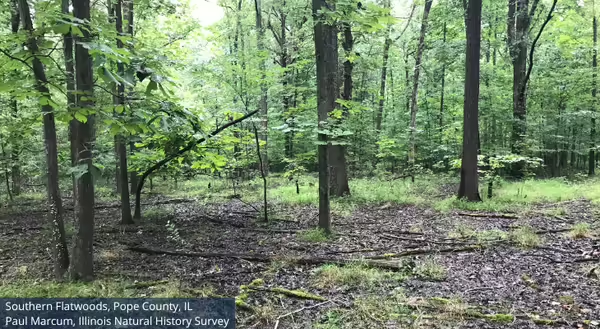
Walking through the woods, you will notice that not all forests are the same. The plant composition, elevation in the land, geography, and soil composition all make for a variety of forest types. One of my favorites and most unique is the flatwood forest.
A flatwoods is a level area with a hardpan underneath that keeps water from draining. This unique feature creates distinctive biodiversity opportunities and a forest composition for the most adaptive species.
Types of flatwoods
There are three basic types of flatwoods in Illinois and all experience high water tables.
- Northern Flatwood Forests, defined by their poor drainage from a perched water table on an aquiclude, which is an impervious glacial till that is somewhat compact. These flatwoods are found in the Northern Illinois counties Cook, Kane, and Lake.
- Southern Flatwood Forests, also defined by poor drainage, but from a true clay hardpan, are found in the southern part of Illinois.
- Sand Flatwood Forests, are the rarest and found in the Kankakee sands in Northeastern Illinois.
Soil features
The soil is what really makes a flatwood. To create flooding conditions, the water either has to be abundant or have something stopping it from draining, like a hardpan. With sand flatwoods being the exception, Illinois flatwoods have hardpans.
A hardpan is a hardened or cemented soil horizon. This paired with a flat topography gives the flatwood forest a perched water table in the spring and fall. Because of the generally flat landscape, the smallest ridges and dips create temporary pools and ponds with dryer conditions directly adjacent. In the summer, the soil dries out creating a variety of conditions that plants and animals must adapt to.
Animals and plants
Animals adapted to flatwoods need both wet and dry conditions to survive. Cue amphibians and insects!
Flatwood forests are important breeding habitat for amphibians and aquatic invertebrates such as dragonflies and damselflies. Northern flatwoods are essential breeding habitat for the blue-spotted salamander, and southern flatwoods serve the same purpose for the north crawfish frog.
Plants must also adapt to the drastic wet and dry conditions in flatwood forests. Tree species, primarily post oak in southern flatwood forests and swamp white oaks in northern flatwood forests, have some unique features due to the perched water table and hardpan. The conditions cause the trees to be stunted with root sprouts.
Flatwood Forest conservation
Not only are conditions unique and create with opportunities for biodiversity, but the forest type itself is fairly rare.
Given its flat topography, it is an ideal spot for plowing and growing row crops. Areas that were not plowed were intensely grazed by livestock, which removed the ground cover layer and caused erosion. Any flatwood forests that went untouched by land changes experienced fire suppression which can cause a decrease in biodiversity of the ground cover layer.
Where you can find flatwood forests in Illinois
This unique forest type has so much to offer in terms of biodiversity, plant composition, and just a neat walk through the woods. When walking through an upland and you start to notice stunted trees with root sprouts, some pooling and ponding, and an overall flat topography, you may have just walked into a flatwood forest.
- Northern Flatwoods: Harms Flatwoods, Cook County.
- Southern Flatwoods: Lake Sara Flatwoods in Effingham County and Posen Woods in Washington County.
- Sand Flatwoods: Iroquois County Conservation Area.
Learn more about flatwood forests
- IDNR Flatwood Forests
- Illinois State Museum Flatwood Forests
- Sand Flatwoods in the Iroquois Conservation Area
MEET THE AUTHOR: Abigail Garofalo is an Energy and Environmental Stewardship Educator for Cook County. She manages the Cook County Master Naturalist program and the Conservation@Home program for University of Illinois Extension. She has a BS in Natural Resources and Environmental Sciences and MS in Agricultural Leadership Education both from University of Illinois Urbana Champaign. Her background in is environmental outreach and interpretation and works to create a culture of environmentalism through community building.
ABOUT THE BLOG: Naturalist News is a blog by University of Illinois Extension Master Naturalist staff and volunteers who bring you stories highlighting the individuals, places, wildlife, and plants that make this state amazing. Join us each week to learn something new, be inspired and become connected to your own community by recognizing the amazing ways we are all intertwined. Want to get notified when new Naturalist News posts are available? Sign up here!